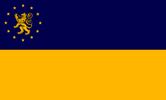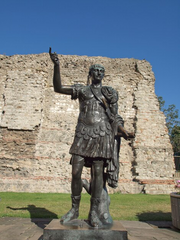Castillia: Difference between revisions
No edit summary |
No edit summary |
||
| Line 161: | Line 161: | ||
All members of the Cabinet of the Federation require the advice and consent of the [[Federal Senate (Castillia|Federal Senate]] following appointment by the President before taking office. The Vice Presidency is exceptional in that the position requires election to office pursuant to the [[Federal Constitution (Castillia|Federal Constitution]]. Although some are afforded cabinet-level rank, non-cabinet members within the Executive Office of the President, such as [[Manoir du Montbatten|Chief of Staff]], National Security Advisor, and [[Manoir du Montbatten|Press Secretary]], do not hold constitutionally created positions and most do not require Senate confirmation for appointment. | All members of the Cabinet of the Federation require the advice and consent of the [[Federal Senate (Castillia|Federal Senate]] following appointment by the President before taking office. The Vice Presidency is exceptional in that the position requires election to office pursuant to the [[Federal Constitution (Castillia|Federal Constitution]]. Although some are afforded cabinet-level rank, non-cabinet members within the Executive Office of the President, such as [[Manoir du Montbatten|Chief of Staff]], National Security Advisor, and [[Manoir du Montbatten|Press Secretary]], do not hold constitutionally created positions and most do not require Senate confirmation for appointment. | ||
The following are members of [[Marlène Backès]]' Cabinet beginning on July 30, 2035 when they were all confirmed by the Federal Senate. For other high-level positions, [[list of Marlène Backès political appointments|see the list of | The following are members of [[Marlène Backès]]' Cabinet beginning on July 30, 2035 when they were all confirmed by the Federal Senate. For other high-level positions, [[list of Marlène Backès political appointments|see the list of Marlène Backès political appointments]]. | ||
{| class="wikitable" style="text-align:center" | {| class="wikitable" style="text-align:center" | ||
! colspan=4 style="text-align:center; font-size:100%; color:white; background:#AE1C23;"|'''Cabinet of President of the Castillian Federation Marlène Backès''' | ! colspan=4 style="text-align:center; font-size:100%; color:white; background:#AE1C23;"|'''Cabinet of President of the Castillian Federation Marlène Backès''' | ||
Revision as of 18:00, 8 June 2024
| Motto: Fraternité sous notre Fédération | |
| Anthem: "Héler Castillia!" | |
| Capital | Preslaff |
| Largest city | Beziers |
| Official languages | Castillian |
| Recognised regional languages | Anglic, Díenstadi |
| Ethnic groups | Castillian, Mokan, Closian, Macabean |
| Demonym(s) | Castillian |
| Government | Federated presidential constitutional republic |
• President of the Federation | Marlène Backès |
• Vice-President of the Federation | Maïté Bacque |
• Cassier des Cinqcents (Speaker of the Five-Hundred) | Léo Rousselle |
| Legislature | États-Généraux (States-General) |
| Fédéralsénat (Federal Senate) | |
| Assemblé des Cinqcents (Assembly of the Five-Hundred) | |
| Formation | |
• Castillian Unification | 1749 CCE |
• Imperial Formation | 1753 CCE |
• Socialistenat Regime | 2005 CCE |
• Federal Constitution | 2015 CCE |
| GDP (PPP) | 2034 estimate |
• Total | $4,010 trillion |
• Per capita | $74,023 |
| HDI (2032) | 0.831 very high |
| Currency | Datary |
| Date format | dd-mm-yyyy CCE (Castillian Common Era) |
| Driving side | right |
| Calling code | +411 |
| Internet TLD | .cas |
Castillia, officially the Castillian Federation, is a federated presidential constitutional republic located in Greater Díenstad. Comprising the entire Viridian continent, a large island landmass in the Dienstadi orient, it is among the largest countries in the region by square mileage. The country's capital and second-largest city is Preslaff, also the cultural capital of Castillia. Beziers is Castillia's largest city and financial capital, being the headquarters of some of the most prominent financial and corporate entities in Greater Dienstad. Other major urban areas in the country include Ariège, Marais Besançon, Élancourt, Nogent-sur-Marne, and Villeparisis. Comprising of twenty-nine provinces, seven grand arrondissements, two autonomous suzerainties, and the Special Capital District, Castillia has a diverse geography, from swamplands and marshes to vast plains, deep old-growth forests, and mountain ranges, including Mont Zénith, the highest point of elevation in Greater Dienstad.
The formal unification of what now comprises the southern half of the Castillian Federation occurred on December 1, 1749, when King Charles II defeated William the Northlander at Battle of Saint-Jean-sur-Richelieu, conquering the Duchy of Halstead and subsequently crowning himself Emperor of Castillia in 1753, the first of nine to hold the title. Castillia was defined by its 304-year Imperial era, during which industrialization, outward colonization, and the establishment of a naval hegemony occured, as well as the emergence of a Castillian identity. In 2005, the First Castillian-Mokan War led to the collapse of the Imperial system, and the Socialistenat seizure of power from the provisional democratic government shortly thereafter. The entire Viridian continent was not unified until 2007, during the Socialistenat regime under Chancellor John Oswald Vaughn, who ordered the annexation of the Kingdom of Castleclose, leading to the Closian Theater in the Great Dienstadi War. Tensions between the Socialistenatètat Castillia and the People's Unified Federation led to the liberation of Castillia from authoritarianism during the Second Castillian-Mokan War seven years later, the opening stage of the wider Fascist and Slaver Wars beginning in 2015. The contemporary Castillian Federation was established the same year, marking the introduction of functional democratic institutions and an open society in Castillia, which had been previously defined by varying levels of repression.
Castillia has been described as a great power with a liberal democratic basic order and a strong economy; however significant political episodes such as the Rails-For-Oil scandal or the Mai '35 Crisis, the government's human rights record, and continued widespread poverty in Castillia's insular, more rural areas as well in its northern reaches, have made Castillia a subject of intense debate. As a rentier state, owing to the large deposits of natural gas and oil in the Federation, its citizens nominally enjoy universal healthcare, social security programs, and tuition-free university education. It is a leader in scientific, industrial, and technological sectors, as well as defined by its unique cultural identity. Castillia is a member of the Greater Dienstadi Regional Council, the World Assembly (since 2035), the Global Aerospace and Trade Association, and a signatory of the Amistad Declaration.
Etymology
History
Prehistory
The earliest known estimate of Homo Erectus settling what is known as the Viridian Isle occurred around 1.8 million years ago, presumably crossing an ice bridge from a now-submerged continent. Controlled use of fire is estimated to have started around 800,000 years ago, with modern humans Homo Sapiens appearing on the Viridian Isle around 200,000 years ago. Spreading along the coastline, they often clashed with Erectus and completely wiped out the species 195,000 years ago. The most significant advent of the Upper Paleolithic was agriculture, developed by Sapiens on the Viridian continent around the 9th millennium BCCE. Evidence proving this was found in an archeological dig near Vensel in the Province of Le Bouscat. By the 5th millennium the wheel had been invented on Viridia, whether that and the concept of agriculture was the first to be discovered in Viridia is unknown and highly contested. Within 2900 BC literate cuneiform has been developed as well as proto-Aacevi, a tongue attributed as being the forebearer to Romance Aacevi. This ends the Neolithic era late in 3200 BCCE and begins the Bronze Age in Viridia, where the development of sturdy tools, formidable weapons, and economy-based civilizations flourish on the continent. This is also noted as the end of the Neolithic for three reasons: (i) the collapse of the Hexatopolic supercontinent due to the eruption of a supervolcano designated "Dominus Priebe", (ii) the subsequent ash cloud that covered the northern area of Greater Dienstad for at least one year, killing 42% of the Sapiens population, and (iii) rise in sea levels covering any existence of the Hexatopolic continent. These events were marked by the first recorded events of history in Viridia. It was treated by many civilizations as an apocalyptic end-time event, however human society flourished after the event, as well as formed significant pantheons.
Early Civilization
First Civilizations
The Aacevivan Kingdom is established around 3219 BCCE, the first known major society and civilization to establish themselves in Viridia. They become rivaled by the Gaellian peoples who establish loosely-confederated farming states in present-day Castleclose. These neighboring states span from the northern tip of Castleclose to Ulster. To the south in what is the original borders of the Castillian state, several city-states vie for power as they are overlooked by the growing Balochians and their wealthy merchant-based economy. Iron Age states such as the Balochians developed mercantile cultures, the concept of barter and currency, and developed military strategy, as evidenced in the Battle of Brivstasvl against the Maecaynites, which was the first recorded battle between civilizations in the Viridian continent. The Balochians victory against the Maecay people at Brivstasvl led to conjunction of the first organized empire. The Balochian people had subsequently liquidated the Maecaynites and either sold them into slavery or killed them outright. The destruction of the Maecay was the first recorded conquest of another ethnic tribe in Viridia, and the Balochians further flourished as they conquered city-states like Helsindi, Gast, Melatia, and Videmal. The most prominent of rulers of the Balochians, Bathkyr, or Bathkyr the Great, led campaigns as far north as the Chaleur Mountains, where inexperience in fighting in cold elements as well as lack of familiarity of terrain led to defeat at the hands of the tribal bands in those areas, such as the Kepti. Retreating over thousands of miles through the brutal winter, pursued by the Kepti and Vegtik tribes back to Balochia, Bathkyr found his empire in disarray as Melatia and Gast had rebelled and the incredible distance he had went to the Chaleur mountains had given him lack of communication with his court back home. With the Kepti and Vegtik warrior closing in on Becik, the capital, and Gast mounting a large army, Bathkyr committed suicide and thus ended the Balochians as they were submitted into slavery by several different tribes and peoples. Becik was razed and sacked by the Kepti, and left to ruin. Becik lies near the modern-day city of Beziers, and some ruins still stand, such as the Temple of Bacidalus.
Early Viridius Republicae
While Balochia was liquidated circa 250 BCCE, Gast had filled the power vacuum and reformed itself into the regional power. With their capital of Viridius on the glimmering shores facing what is now Mokastana, the people of Gast had reformed themselves into the Viridius Republicae, using what technology the Balochians had developed and with the minds of some of the greatest philosophers and inventors such as Saetonius, Fiscus Pilus, Contarch, and Belphaestus, over the course of 50 years, develop Viridius into a beautiful flourishing city with freshwater brought in from lakes on hundreds of miles of aqueduct networks. The Senate, the ruling class of citizens who dictated the policy of Viridius Republicae, was led by a triumvirate of princeps, or "First Citizens". The Triumvirate reached the peak of its power in 192 BCE, when it was led by the "The Three Good Men", namely Cassius Lucidus, Albinovanus, and Aeschrion of Aethella (also known as Aeschrion the Undaunted), and was notable in history for being the last triumvirate before the Junia Conspiracy in which led to a three-year power vacuum and formed the Republicae into the what is now known as the Viridian Empire.
Cassius Lucidus was a well-known financier in the Viridius forum, and had considerable influence in buying his way into the Senate using his vast fortune. Cassius had owned silver mines north of Viridius, in the border regions between the farthest reach of the Republicae and the Pantharian Kingdoms, and also invested much of his fortune into wine and olive oil production, owning a considerable chunk of the market in those two products. Albinovanus came from an already-powerful political dynasty, being the fifth senator of his family. Albinovanus was also an accomplished statesman, having brokered peace between the Republicae and the Galatia Thalassokratia in 194 BCCE after nearly a decade of bloodshed between the two neighbors. Aeschrion, who was not a native of the Republicae but of Aethella and was "naturalized" after being sent to train under the tutelage of Cathellus, a skillful early Republicae military commander, who had seen many engagements in the Thalassokratian Wars and had considerable victories at Amnisos, Berge, and Edessa. Aeschrion, becoming a military commander alongside Cathellus and earning his right as a Republicae citizen, earning a reputation for fierce tenacity in battle and wise command decisions while also racking up much debt living a lavish lifestyle much beyond his means. His place in the Triumvirate was only guaranteed by Cassius, who paid the debts and funded an expedition for Aeschrion to then repay his debt to Cassius. In 193 BC, Aeschrion set out with 10,000 men, IX Aavecrates Legio, to rally against the Sullenic tribes to the east in Sulla. After nine months and numerous victories against Gastian (scholars debate whether his name referenced the origin of the Viridian Republicae and its people, despite being of Gaellian ethnicity) and his Sullenic warriors, defeating them finally after a month-long siege at Taevel (near present-day Élancourt), and taking all of the city's coffers in silver by the pound a thousand, as well as nearly five-thousand slaves, which were sold at home in the Republicae and abroad. By 190 BCCE, Aeschrion had paid his debts to Cassius and emerged as a wealthy rival to him. Conspiring to eliminate opposition to him, Aeschrion arranged for the assassination of Albinovanus, which occurred on Juin 19, 190 BCCE when mercenaries organized by Aeschrion publicy beat Albinovanus to death with wooden poles in the middle of the forum of Viridius.
Albinovanus' assasination was never connected to Aeschrion, as he controlled the city garrison and enjoyed the discretion of its commanders, who led a lackluster investigation into the murder. Cassius saw this as a warning sign to not only his power in the Republicae, but his own life, and lobbied the commanders of several military units to his cause, calling for the dissolution of the Triumvirate and the arrest of Aeschrion. Despite this, most of the political elite in the Senate, including the military officers who held office in the Senate, sided with Aeschrion and organized their troops to go to battle against Cassius' forces. This power struggle culminated in the Battle of Viridius, which tore the city apart as the two armies clashed. While the city sustained much damage, Aeschrion's forces ultimately prevailed and Cassius was cornered in the Temple of Sianius, where he was captured and paraded through the streets while tied to a stake. In his first act as the newly established Diktat, Aeschrion tried Cassius in the Senate, where he was found guilty and in a stroke of fortune for Cassius, was sentenced to exile. Aside from the fact that he traveled north into the Montagnes des Chaleurie. Most academics concur that he likely died somewhere in the mountain range.
High Viridius Republicae and Fall
Aeschrion's unopposed rule as the Diktat was rather short; for 151 days he presided over affairs of the Republicae enacting wide reaching reforms of the political system, diminishing the power of the landed elite in the Senate. Discontent with the stifling of their power, the landed elite, led by Tallius, in turn assassinated Aeschrion when the Senate convened in Viridius. This ushered in the establishment of a new system where the Senate would elect a praeses, who presided over the Senate.
The Castulingians
The Viridian Republicae would disintegrate by 327 CCE, reduced to mere warring kingdoms and other feudal states. The vast empire that reached across much of the southern Viridian continent had ceased to exist. Most prominent among the new realms was the Castulingians, which hailed north of the Chaleurie range from Viridius, in the lush fertile farmlands of the Bellevallée. The Castulingians,
Middle Ages
The Castulingian Church
Expeditions to the Mokan continent
Castillian Renaissance
Castillian Unification
The Warring Kingdoms
From the late 17th century to the mid-18th century, a slow process of conquest headed by the Kingdom of Castillia, the most powerful polity among the other post-feudal states in the southern half of the Viridian continent.
The Battle of Saint-Jean-sur-Richelieu
Modern Empire
The Coronation of Charles II
Introduction of the Montbatten System
Industrialization
Mortidentitaire and the Third Carolean Era
The Glorious Revolution of 1935
Fourth Carolean Era
Titusian Era and Collapse
National Socialism
Chalmont Republic
Seizure of Power
Militarization and Annexation of Castleclose
Varathron Blood Fever Outbreak of 2013
Operation Haricot and Second Castillian-Mokan War
Federal Unification
Federal Proclamation No. 1
Closian Crisis
Occidental Wars
Mai '35 Crisis
Geography
Government and Politics
Administration
Executive Branch
All members of the Cabinet of the Federation require the advice and consent of the Federal Senate following appointment by the President before taking office. The Vice Presidency is exceptional in that the position requires election to office pursuant to the Federal Constitution. Although some are afforded cabinet-level rank, non-cabinet members within the Executive Office of the President, such as Chief of Staff, National Security Advisor, and Press Secretary, do not hold constitutionally created positions and most do not require Senate confirmation for appointment.
The following are members of Marlène Backès' Cabinet beginning on July 30, 2035 when they were all confirmed by the Federal Senate. For other high-level positions, see the list of Marlène Backès political appointments.
| Cabinet of President of the Castillian Federation Marlène Backès | |||
|---|---|---|---|
|
Individual elected to office, and does not serve at the pleasure of the President of the Castillian Federation (all other cabinet members do)
Individual took office with no legislative consent needed
Cabinet members on July 30, 2035 | |||
| Office Date announced / confirmed |
Designee | Office Date announced / confirmed |
Designee |
 – |Vice President Announced August 24, 2034 Elected May 25, 2035 Took office July 15, 2035 |
 Former Governor Maïté Bacque of Chaleur |
 – Secretary of State Announced June 1, 2035 Took office July 30, 2035 |
 Director of National Intelligence Rémy Courvoisier of Laussat |
 – Secretary of the Treasury Announced June 1, 2035 Took office July 30, 2035 |
 Former Pan Díen CEO Marisol Cazeneuve of Périyonne |
 – Secretary of Defence Announced June 1, 2035 Took office July 30, 2035 |
 Former Field Marshal Jean-Marc Galfetti of Preslaff |
 – Attorney General Announced June 1, 2035 Took office July 30, 2035 |
 Former SSF Director Nicolas Leroux of Hermôtier |
 – Secretary for the Administration of the Government Announced June 1, 2035 Took office July 30, 2035[n 1] |
 Federal Attorney for the Eastern District of Ostersoix Isabelle Véran of Ostersoix |
 – Secretary for Administrative Security Announced June 1, 2035 Took office July 30, 2035 |
 Former Governor Luc Baume of Vitroluire |
 – Secretary of Commerce Announced June 1, 2035 Took office July 30, 2035 |
 Former Voiture Castillia SA CEO Hélène Pélissard of Périyonne |
| Secretary of Labour Announced June 1, 2035 Took office July 30, 2035 |
 Former Teamsters Union General President Richard Arrende of Lernoult |
Secretary of Public Health Announced June 1, 2035 Took office July 30, 2035 |
 Former Deputy Secretary Jean-Paul d'Hauteserre of Chaleur |
| Secretary of Education and Culture Announced June 1, 2035 Took office July 30, 2035 |
 Former Deputy Secretary Jacqueline Beauregard of Draguilès |
Secretary of Transportation Announced June 1, 2035 Took office July 30, 2035 |
 Deputy Secretary Frédéric Bettencourt of Colçon |
| Secretary of Energy Announced June 1, 2035 Took office July 30, 2035 |
 Senator Peter Camarata of Laussat |
Secretary of Agriculture Announced June 1, 2035 Took office July 30, 2035 |
 Former Special Envoy Cyrille Thibodeau of Marilême |
| Secretary of Communications Announced June 1, 2035 Took office July 30, 2035 |
 Former Castillian Broadcasting Corporation CEO Florence Asselineau of Marciennes |
Secretary of the Interior Announced June 1, 2035 Took office July 30, 2035 |
 Former Senator Michel Belliard of Marciennes |
Cabinet-level officials | |||
| Office Date announced / confirmed |
Designee | Office Date announced / confirmed |
Designee |
| Manoir du Montbatten Chief of Staff Announced June 1, 2035 Took office July 15, 2035 |
 Former Cassier des Cinqcents Michaël Choffard of Périsir |
Federal Trade Representative Announced June 1, 2035 Took office July 30, 2035 |
 Former Federal Ambassador to the Greater Dienstadi Regional Council Chet Litheau of Laussat |
| Director of National Intelligence Announced June 1, 2035 Took office July 30, 2035 |
 Former Administrator of Narcotics Control Mathéo Popelin of Chaleur |
Administrator of the Castillian Space Administration Announced June 1, 2035 Took office July 30, 2035 |
 Former Cosmonaut and Military Officer Léon Trémaux of Villeurluçon |
| Senior Advisor to the President National Security Advisor Announced June 1, 2035 Took office July 15, 2035 |
 Former SSF Director of Counterintelligence Stéphane Carrel of Périyonne |
| |
| Source: Backès Administration and Associated Media | |||



